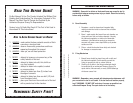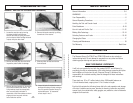
-13-
-6-
© Copyright 2004 SIMPSON STRONG-TIE COMPANY INC.
© Copyright 2004 SIMPSON STRONG-TIE COMPANY INC.
A. TRAINING
1. Remember you must obtain certification of training from an authorized
Simpson Strong-Tie instructor. If such training is not available where
you purchased the tool, call or write Simpson Strong-Tie before
attempting to operate the tool for information on the nearest
authorized instructor. Remember obtaining this instruction is
YOUR RESPONSIBILITY
.
2. Read this manual completely and understand its contents fully before
attempting to operate the tool. If there is anything in this manual that
you do not fully understand, ask your instructor or call Simpson
Strong-Tie for information. Remember reading and understanding
this manual is
YOUR RESPONSIBILITY
.
B. LIMITATIONS
1. Just as no instruction book of any kind can forewarn a learner against
all possible situations or emergencies that may arise, neither can
Simpson Strong-Tie instructors or printed instructions detail all possible
conditions or circumstances surrounding the use of this tool or its
supporting products. Recognizing these circumstances and reacting
in a safe manner is
YOUR RESPONSIBILITY
.
2. Simpson Strong-Tie disclaims any responsibility for injury or death,
which may result from any disregard of this manual or the verbal
instruction of the authorized Simpson Strong-Tie instructor. Following
the rules of safe operation given to you here and verbally is
YOUR RESPONSIBILITY
.
SAFETY STARTS WITH YOU!!!
OBTAIN AUTHORIZED TRAINING
There is no substitute for good common sense; however, knowing and
understanding the following basic rules will help ensure safe use of
Simpson Strong-Tie tools.
A. CENTER PUNCH TESTING: Before making a fastening always test the base
material and the work piece. Using a long Simpson Strong-Tie fastener, a
hammer AND SAFETY GLASSES, place the point of fastener against the
surface to be tested and strike the head with an average hammer blow.
DO NOT FASTEN THROUGH OR INTO A MATERIAL IF:
1. The fastener point is blunted - this material is too hard.
2. The material cracks or shatters - this material is too brittle.
DO NOT FASTEN INTO A BASE IF:
1. The fastener sinks easily into the surface with an average blow - this
material is too soft - fastener may penetrate causing serious injury
or death.
REMEMBER: Use for a base material only a substance that shows an
impression when tested by the center punch method, but that does NOT blunt
the point of the fastener, does NOT crack or shatter, and does NOT receive the
fastener easily with an average hammer blow.
B. APPLICATIONS FOR THE PTM-27 and PTM-27HD: Both these tools are
capable of making a wide range of fastenings; however each has a general
purpose for which it was designed.
1. PTM-27 - a heavy-duty tool for the professional who requires
the high-speed production of a 10 shot strip load tool.
2. PTM-27HD - the same heavy-duty tool but for the professional who
fastens daily but prefers the versatility and economy of a single
shot tool.
C. MINIMUM SPACING AND BASE MATERIAL THICKNESS
1. Edge spacing when fastening in concrete must be at least 3" and in
steel at least 1". Fastening too close to the edge may cause the
fastener to break out and ricochet.
2. Spacing between fasteners is equally important in concrete.
Maintain a 4" spacing for 1/4" fasteners, and 6" for 3/8" fasteners.
In steel maintain a 1-1/2" spacing for both diameter fasteners.
YOUR RESPONSIBILTY
MAKING SAFE FASTENINGS












